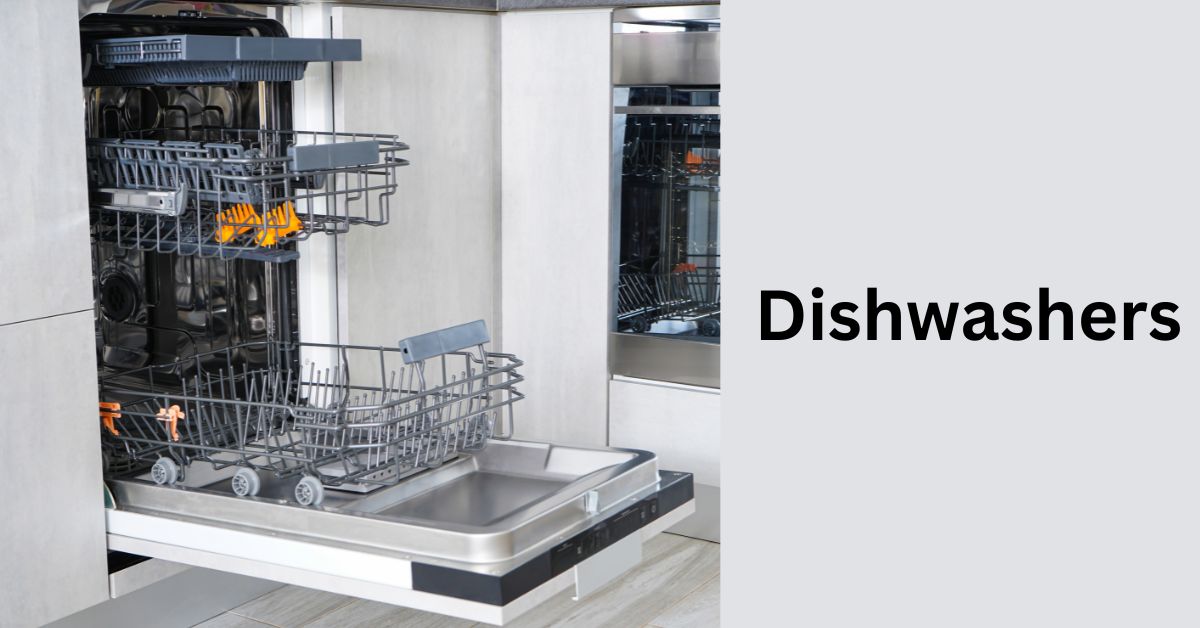Table of Contents
Note: If you came to this post on dishwashers through a random search, please click on this parent page and our home page for more context.
Dishwasher Priority
Always plan for your dishwasher before you settle on the design of your kitchen cabinetry. This is because the type and location of the dishwasher affect it. So let’s take a look at how to choose a dishwasher
- Related post: Kitchen Layout
Dishwasher Options
There are three dishwasher types: countertop dishwashers, standard dishwashers, and drawer dishwashers.
The countertop or portable dishwasher sits on the kitchen counter. They are a great and economical option for people who have cramped kitchens or who move frequently.
However, since our focus is on remodeling, we limit our discussion to:
- The conventional dishwasher with its drop-down front
- The single drawer, stacked drawer, and side-by-side drawer dishwasher.
Conventional Dishwashers
Conventional dishwashers come in compact and standard sizes
Compact Conventional Dishwasher
The compact dishwasher fits a cabinetry gap only 18” wide. It will suit someone who lives alone or with one other person, or who has a small kitchen.
Standard Conventional Dishwasher
The standard dishwasher has a finished front and unfinished sides. It fits into a cabinet space 24” wide, 24” deep, and 35” high. Cabinetry is designed to accommodate these standard dimensions.
The standard dishwasher suits regular kitchens, families, and entertaining. And, if you are remodeling your kitchen, this is the size you will be working with.
Even if you are personally inclined towards a compact dishwasher and you have room for a standard dishwasher, don’t be tempted. You always have to consider resale and the home-buying market will expect to see a standard dishwasher capacity.
Standard Dishwasher Options
You can expect to pay anywhere from around $400 to $900 for a standard dishwasher. And within that range, there are many features to choose from. Your own needs, experience, and budget will be the best judge of that.
But, from the remodeling and value-add point of view, we do have these recommendations:
Stainless Steel Interior
While stainless steel is somewhat more expensive, it is more durable and stain resistant than plastic. Also, it retains heat better than plastic and will cause dishes to dry faster. It is more energy efficient. It is also quieter because it dampens the sound of the water that sprays inside the machine.
So get a dishwasher with a stainless steel interior.
Quiet Operation
You do not want a dishwasher that interrupts a conversation or causes you to turn up the radio or TV. Quiet operation is especially important because, in the modern home, the kitchen and living areas have merged.
This means that the noise made by the dishwasher is no longer confined to the kitchen.
So look for several things that make for quiet operation:
- A good sound attenuation package. This might include layers of insulation and a shock/sound absorbing base and mounting feet.
- A dishwasher without a hard food disposer or self-cleaning filter. These are noisy.
- A dishwasher with a low decibel rating
How Many Decibels Make a Quiet Dishwasher?
There is no industry-wide standard for measuring decibels. But manufacturers do publish a decibel rating for their dishwashers. Models rated from 38 to 44 decibels are considered quiet.
Compare this with a whisper, which is about 15 decibels. A normal conversation is about 60 decibels. Thus, the lower the decibel number, the quieter the dishwasher operation.
Dishwasher Placement
The dishwasher can in theory be placed anywhere there is a water supply, drainage, and electric power. But in practice, it only makes sense to put it immediately to the left or right of the kitchen sink. Here’s why:
It’s the best operational position because we typically scrape a dish or platter into the disposal, rinse it, and then place it into the dishwasher. We want to be able to do this without moving our feet.
The necessary power and water supply are already close by under the sink. Typically, there is an existing power supply for the disposal with a separate outlet for the dishwasher. And, of course, there is a water supply to the sink faucets. The dishwasher gets hooked into the cold water supply line.
This is the arrangement dishwasher manufacturers expect. So they supply the appropriate length hoses and power cords with the unit.
- Related post: Kitchen Sinks
Dishwasher to the Right or Left of the Kitchen Sink?
This depends if you are left or right-handed. If your right hand is dominant, the dishwasher should be to the left of the sink. Most right-handed people find this makes the action of scraping, rinsing, and then loading the dishwasher easier that way. Vice versa, if you are left-handed.
Coordinate Storage with the Dishwasher
Pair your cabinetry with the dishwasher. Place the drawers and cabinets that will take the clean cutlery and crockery that you remove from the dishwasher close by.
- Related post: Kitchen Cabinets
Plan for the Drop Front of the Dishwasher
Be aware of the overall kitchen layout.
Do not place the standard drop front dishwasher where it will interfere with accessing and opening an oven or refrigerator door.
Of course, since you have limited choice in the location of the dishwasher, this will likely affect where you place the oven or refrigerator.
Standard Dishwasher Installation
A sub-theme of this site is Universal Design and aging in place. Universal Design just means designing and building with the comfort of everyone in mind. And so we include this approach in evaluating dishwashers for a kitchen remodel.
The standard dishwasher comes with the same drawback as the standard cooktop/oven range combo. Stooping to deal with the low-drop front dishwasher door is just plain difficult for the elderly.
So, if you have aging in place in mind for a standard dishwasher, we suggest putting the standard dishwasher on a pedestal or drawer cabinet. This helps reduce the strain of bending and stooping.
But, this has the knock-on effect of raising a 24-inch section of the countertop by around 12 inches. This is not so good for kitchen functionality but it is an option. Also, you can mitigate this undesirable effect by imaginative cabinetry design.
Your best aging-in-place dishwasher option is the drawer dishwasher (see further below).
- Related post: Kitchens for the Elderly
Dishwasher Next to a Refrigerator?
No. Do not do this. Dishwashers produce heat and humidity. These are the two things the refrigerator is trying to expel in performing its cooling function.
It only makes sense. The dishwasher wants to be “hot” and the fridge wants to be “cold.” So it’s obvious they should be separated.
In addition, there is a functional conflict arising out of the refrigerator and dishwasher doors being next to each other. Think about someone trying to get something out of the fridge while another person is loading or unloading the dishwasher.
Dishwasher Next to an Oven?
It is best not to do this.
But, if the kitchen layout forces it, you can put a dishwasher side by side with a slide-in range but not directly touching it. There needs to be a minimum 2’ clearance between the two units to allow for heat dissipation. And you can further mitigate the situation by inserting a sheet of foam insulation between them
Why do Dishwashers Need an Air Gap?
The air gap is a backflow preventer. It is the anti-siphon device whose little decorative cap sits next to the faucet on your kitchen sink. It prevents the backflow of wastewater from the dishwasher drain system into the freshwater supply. This could happen, for example, if the garbage disposal gets clogged.
Many building codes require the installation of an air gap. If yours does not and you do not want to see the air gap by your kitchen faucet for aesthetic reasons, install a “high loop” drain hose. This too is a backflow preventer but is not as reliable as the air gap. Your plumber will advise.
Most Reliable Dishwasher Brands
From the dishwasher reviews we have studied, you can’t go far wrong with Miele, Maytag, Kitchenaid, Frigidaire, or Bosch for a standard dishwasher.
Standard Dishwashers on Amazon
Drawer Dishwashers
Drawer dishwashers come in several sizes and configurations, depending on your need. They are a relatively new technology and only one manufacturer, Fisher & Paykel, makes them. They were launched in 1997, overcame some early technical issues, and are now considered reliable.
Fisher & Paykel is owned by GE Appliances, which is now Haier.
Single Drawer Dishwasher
As with the standard compact dishwasher, the single dishwasher drawer is good for small kitchens and for people with minimal dishwashing needs. It occupies 24 or 36 inches of cabinetry in width and 19 inches in height, depending on the height of the drawer. It is placed immediately below the countertop.
This location makes the drawer dishwasher ergonomically friendly since you do not have to stoop to operate it.
Stacked Drawer Dishwasher
The stacked or double-drawer dishwasher occupies the same opening as a standard dishwasher. Each drawer can be operated independently depending on the washing load demand.
However, this arrangement suffers from the same drawback as the standard dishwasher. This is because you have to stoop to operate the lower drawer. So we do not recommend this configuration.
Side-by-Side Dishwasher Drawers
This is where you install two single Fisher Paykel dishwasher drawers. We prefer the arrangement where one is on each side of the kitchen sink just below the counter. One would be the 18” high version and the other a Fisher Paykel tall dishwasher. This will accommodate larger items.
Here are the reasons for doing this:
- Together they have the same capacity or better as a standard single dishwasher but offer better flexibility of use.
- Being installed just below the counter makes side-by-side dishwasher drawers much easier to use. They are more accessible than the standard dishwasher which requires an awkward bend or stoop to load and unload.
- And for people in wheelchairs, they are much easier to maneuver around than the standard pull-down front dishwasher.
- Water consumption per drawer is less than the standard dishwasher and there is an opportunity for energy savings. Because depending on the load you have to wash, you may only need to use one of the drawers.
So, the side-by-side Fisher & Paykel dishwasher drawer has our vote for the best dishwasher setup for your remodel project.
Granted, they are expensive compared to the standard dishwasher. But for overall long-term utility and enjoyment, this dishwasher drawer arrangement beats everything else hands down, especially for aging in place.
By the way, remember that two dishwasher drawers will require a dual inlet air gap.









Leave a Reply